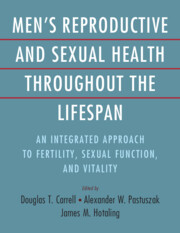 Men's Reproductive and Sexual Health Throughout the Lifespan
Men's Reproductive and Sexual Health Throughout the Lifespan from Section 3 - Clinical Evaluation and Treatment of Male Infertility
Published online by Cambridge University Press: 06 December 2023
Male-factor infertility contributes significantly to the burden of infertility. Fortunately, many causes of male-factor infertility are amenable to surgical intervention. These interventions can be grouped broadly into three categories: 1) those that improve sperm delivery, including vasovasostomy, vasoepididymostomy, and transurethral resection of the ejaculatory ducts, for obstruction of the vas deferens, epididymitis, and ejaculatory ducts, respectively; 2) those that improve testicular function and optimize spermatogenesis, namely varicocelectomy; and 3) those that enable direct retrieval of sperm from either the epididymis (microsurgical epididymal sperm aspiration and percutaneous epididymal sperm aspiration) or testicle (testicular sperm aspiration and testicular sperm extraction). When used in conjunction with other assisted reproductive techniques, including IVF/ICSI, these surgical procedures have vastly improved the reproductive outlook for many subgroups of infertile men who had previous been considered completely infertile.
To save this book to your Kindle, first ensure no-reply@cambridge.org is added to your Approved Personal Document E-mail List under your Personal Document Settings on the Manage Your Content and Devices page of your Amazon account. Then enter the ‘name’ part of your Kindle email address below. Find out more about saving to your Kindle.
Note you can select to save to either the @free.kindle.com or @kindle.com variations. ‘@free.kindle.com’ emails are free but can only be saved to your device when it is connected to wi-fi. ‘@kindle.com’ emails can be delivered even when you are not connected to wi-fi, but note that service fees apply.
Find out more about the Kindle Personal Document Service.
To save content items to your account, please confirm that you agree to abide by our usage policies. If this is the first time you use this feature, you will be asked to authorise Cambridge Core to connect with your account. Find out more about saving content to Dropbox.
To save content items to your account, please confirm that you agree to abide by our usage policies. If this is the first time you use this feature, you will be asked to authorise Cambridge Core to connect with your account. Find out more about saving content to Google Drive.